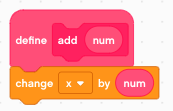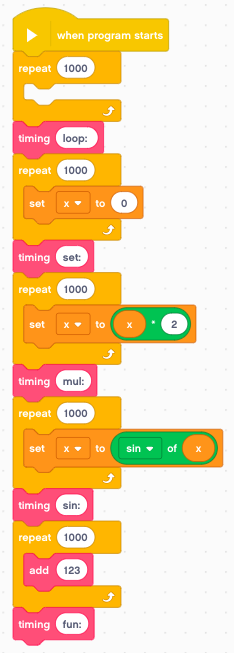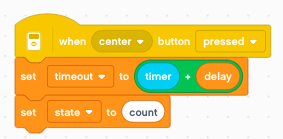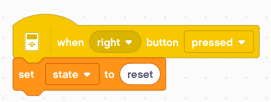Timer¶
The EV3 has a timer which starts counting when the program starts.
Display the timer¶
The timer is a varible which is incremented by the micro-processor. It tells the time in seconds since start-up or the last timer reset. It has milli-second precision.

The reset timer function sets the timer back to 0.

The when timer event activates a single event when the timer crosses the given threshold.

Measure EV3 speed¶
Now we can measure how much it takes for the EV3 to execute its operations. The idea is to repeat a function 1000 times in a loop to have a good precision. Let’s define a function timing which:
- increments the line number
- writes a text
- multiplies the timer with 1000 (to obtain microsecons)
- add us
- reset the timer for the next mesasurement

We will also use a self-defined function add.

These are several loops used to make the timings.

This is the result:
loop: 43 us
set: 62 us
mul: 92 us
sin: 101 us
fun: 927 us
This gives us a rough idea how long different blocks take to execute:
- 43 us for a loop
- 20 us for a set (variable assignment)
- 30-40 us for a math operation (add, mul, sin, etc.)
- 900 us for a user-defined function (My block)
While basic operations take 50-100 us, the user-defined functions have a 20-times overhead.
Kitchen timer¶
To program this timer we will use the technique of the state machine. In our case we have 3 states:
- reset
- count
- alarm
We define 3 variables:
- delay is the duration of the count-down in seconds
- state is one of the strings reset, count, alarm
- timeout is the point in time of the alarm
In the reset state we set the delay with the up/down buttons.

With the center button we set the timeout to timer + delay and switch to the count state.

With the left button we stop the alarm sound and return to the reset state.

The state machine consists of a forever loop with 3 if* blocks which check for the 3 states.
- in reset state, we just show the delay
- in count state, we show the count-down
- in alarm state, we repeat the alarm sound

Notice here, that we never need to reset the timer. This can be important in timing applications for not losing precision.
The timer is displayed in line 1 and the state in line 2.
